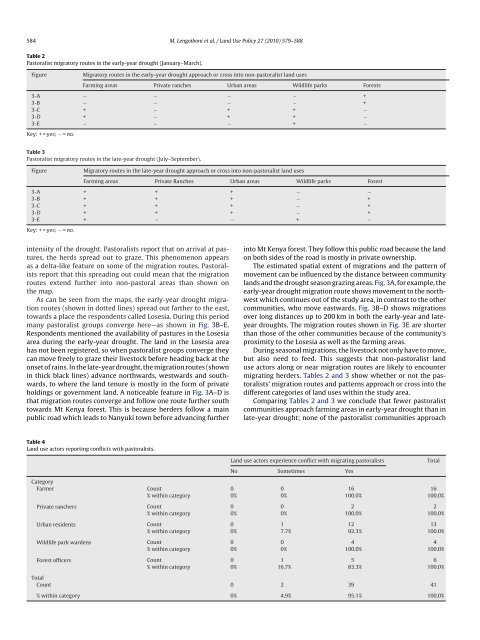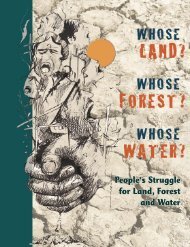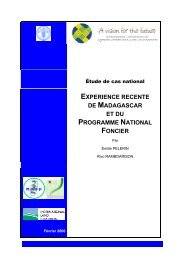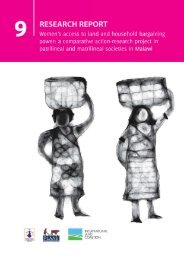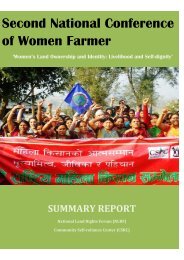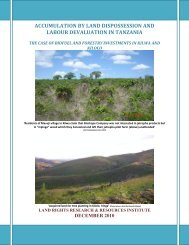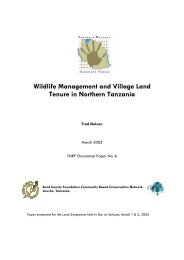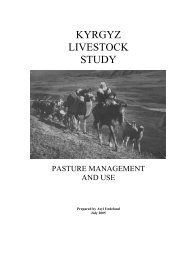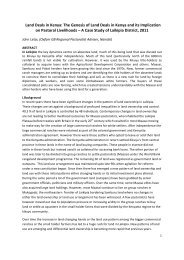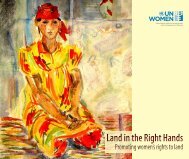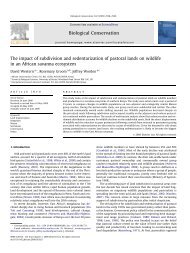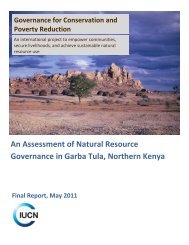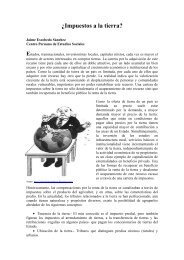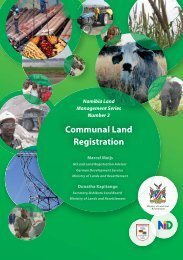Land Use Policy Pastoralism within land administration ... - Land Portal
Land Use Policy Pastoralism within land administration ... - Land Portal
Land Use Policy Pastoralism within land administration ... - Land Portal
You also want an ePaper? Increase the reach of your titles
YUMPU automatically turns print PDFs into web optimized ePapers that Google loves.
584 M. Lengoiboni et al. / <strong>Land</strong> <strong>Use</strong> <strong>Policy</strong> 27 (2010) 579–588<br />
Table 2<br />
Pastoralist migratory routes in the early-year drought (January–March).<br />
Figure Migratory routes in the early-year drought approach or cross into non-pastoralist <strong>land</strong> uses<br />
Farming areas Private ranches Urban areas Wildlife parks Forests<br />
3-A − − − − +<br />
3-B − − − − +<br />
3-C + − + + −<br />
3-D + − + + −<br />
3-E − − − + −<br />
Key: + = yes; − = no.<br />
Table 3<br />
Pastoralist migratory routes in the late-year drought (July–September).<br />
Figure Migratory routes in the late-year drought approach or cross into non-pastoralist <strong>land</strong> uses<br />
Farming areas Private Ranches Urban areas Wildlife parks Forest<br />
3-A + + + − −<br />
3-B + + + − +<br />
3-C + + + − +<br />
3-D + + + − +<br />
3-E + − − + −<br />
Key: + = yes; − = no.<br />
intensity of the drought. Pastoralists report that on arrival at pastures,<br />
the herds spread out to graze. This phenomenon appears<br />
as a delta-like feature on some of the migration routes. Pastoralists<br />
report that this spreading out could mean that the migration<br />
routes extend further into non-pastoral areas than shown on<br />
the map.<br />
As can be seen from the maps, the early-year drought migration<br />
routes (shown in dotted lines) spread out farther to the east,<br />
towards a place the respondents called Losesia. During this period<br />
many pastoralist groups converge here—as shown in Fig. 3B–E.<br />
Respondents mentioned the availability of pastures in the Losesia<br />
area during the early-year drought. The <strong>land</strong> in the Losesia area<br />
has not been registered, so when pastoralist groups converge they<br />
can move freely to graze their livestock before heading back at the<br />
onset of rains. In the late-year drought, the migration routes (shown<br />
in thick black lines) advance northwards, westwards and southwards,<br />
to where the <strong>land</strong> tenure is mostly in the form of private<br />
holdings or government <strong>land</strong>. A noticeable feature in Fig. 3A–D is<br />
that migration routes converge and follow one route further south<br />
towards Mt Kenya forest. This is because herders follow a main<br />
public road which leads to Nanyuki town before advancing further<br />
Table 4<br />
<strong>Land</strong> use actors reporting conflicts with pastoralists.<br />
into Mt Kenya forest. They follow this public road because the <strong>land</strong><br />
on both sides of the road is mostly in private ownership.<br />
The estimated spatial extent of migrations and the pattern of<br />
movement can be influenced by the distance between community<br />
<strong>land</strong>s and the drought season grazing areas. Fig. 3A, for example, the<br />
early-year drought migration route shows movement to the northwest<br />
which continues out of the study area, in contrast to the other<br />
communities, who move eastwards. Fig. 3B–D shows migrations<br />
over long distances up to 200 km in both the early-year and lateyear<br />
droughts. The migration routes shown in Fig. 3E are shorter<br />
than those of the other communities because of the community’s<br />
proximity to the Losesia as well as the farming areas.<br />
During seasonal migrations, the livestock not only have to move,<br />
but also need to feed. This suggests that non-pastoralist <strong>land</strong><br />
use actors along or near migration routes are likely to encounter<br />
migrating herders. Tables 2 and 3 show whether or not the pastoralists’<br />
migration routes and patterns approach or cross into the<br />
different categories of <strong>land</strong> uses <strong>within</strong> the study area.<br />
Comparing Tables 2 and 3 we conclude that fewer pastoralist<br />
communities approach farming areas in early-year drought than in<br />
late-year drought; none of the pastoralist communities approach<br />
<strong>Land</strong> use actors experience conflict with migrating pastoralists Total<br />
No Sometimes Yes<br />
Category<br />
Farmer Count 0 0 16 16<br />
% <strong>within</strong> category 0% 0% 100.0% 100.0%<br />
Private ranchers Count 0 0 2 2<br />
% <strong>within</strong> category 0% 0% 100.0% 100.0%<br />
Urban residents Count 0 1 12 13<br />
% <strong>within</strong> category 0% 7.7% 92.3% 100.0%<br />
Wildlife park wardens Count 0 0 4 4<br />
% <strong>within</strong> category 0% 0% 100.0% 100.0%<br />
Forest officers Count 0 1 5 6<br />
% <strong>within</strong> category 0% 16.7% 83.3% 100.0%<br />
Total<br />
Count 0 2 39 41<br />
% <strong>within</strong> category 0% 4.9% 95.1% 100.0%


